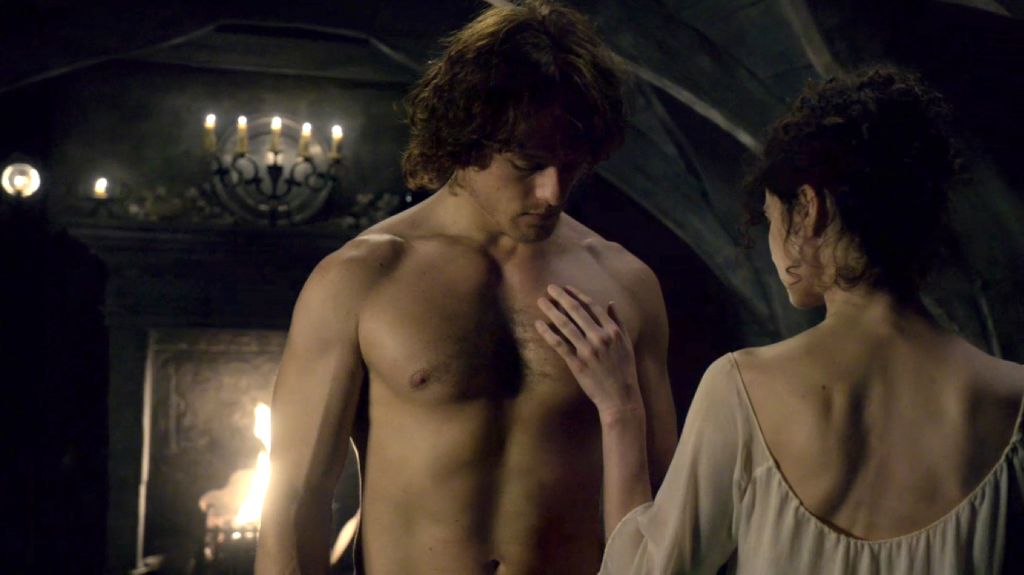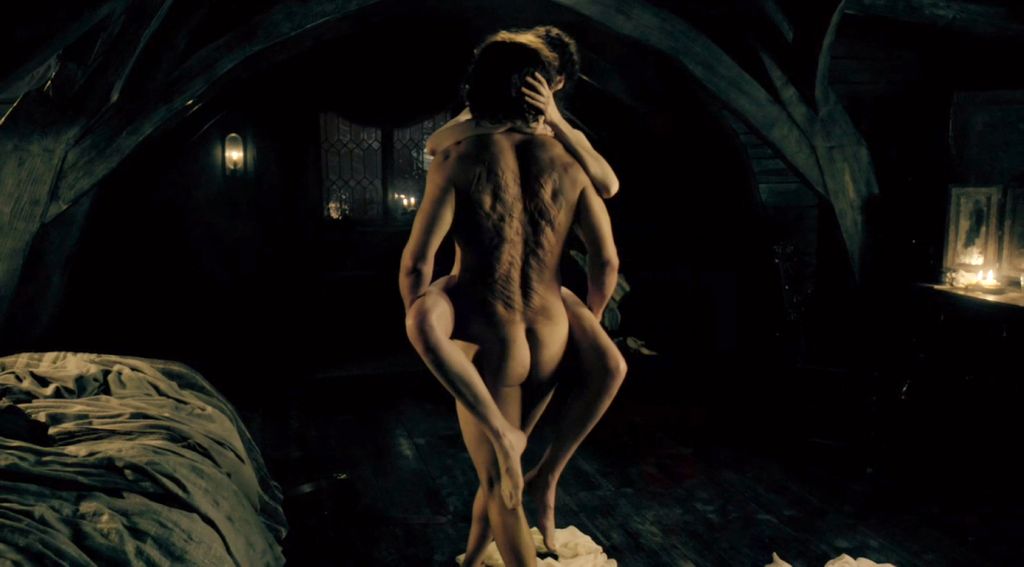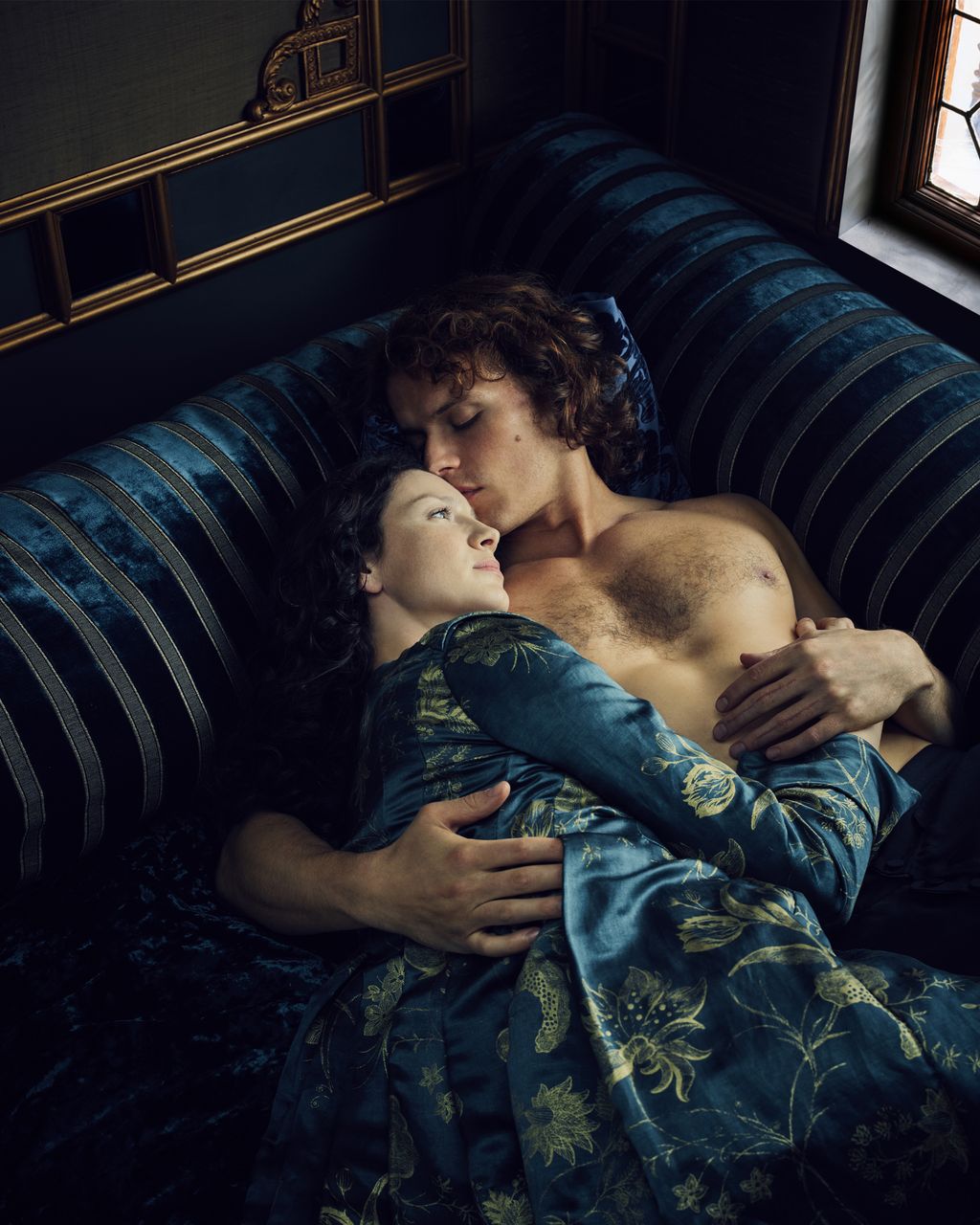It started with the castle cunnilingus. The first sex scene on Outlander was a statement — “a shot across the bow,” as co–executive producer Maril Davis puts it — about how sex would be portrayed on the genre-defying Starz show, a mash-up of sci-fi fantasy, action-adventure, and historical fiction. Claire, our heroine, takes a tour of castle ruins with husband Frank in the year 1945. World War II is over, they’re finally reunited on a Scottish vacation, and it’s time to reconnect. She sits on a dusty table and hikes up her skirt suggestively, showing her garters. He discovers she’s not wearing any underwear. She pushes him to his knees. Claire, without having bared her body, thoroughly enjoys herself. “She was the one asking for it, she was the one directing him what to do,” says Caitriona Balfe, who plays Claire. “We’re so used to seeing women being objectified, as objects of desire of men, but it’s rare when you see a woman owning her sexuality, directing it, orchestrating the sequence of events.”
That first episode may have set the show’s tone, but the moment that turned it into both a feminist and a television darling happened about halfway through the season, on Claire’s wedding night. “It’s one of the most blatant manifestations of the female gaze,” the A.V. Club noted. “One of the few sex scenes I’ve ever seen that felt like it wasn’t written explicitly for men. GAZE, LADIES, GAZE,” Jezebel urged. The feminist writer Roxane Gay was even more blunt in her Vulture recap: “This episode was perfect, poignant, and perfect.” Viewers agreed; 5.2 million have watched the wedding-night episode, according to Starz.
Fans of Diana Gabaldon’s best-selling book series of the same name, on which the show is based, had spent many a message-board thread debating whether the television adaptation would be as emotional and erotic as was the version on the page. The wedding-night scene portrays the first time between Claire and Jamie, hubby No. 2. Claire and Frank have been separated once again — this time by accidental time travel – after Claire touches some mystical stones and is zipped to 200 years in the past and dropped into the middle of a skirmish between British soldiers and Scottish Highlanders. Stuck in 1743 and not knowing how to get back, she eventually marries a hunky Highlander for a pragmatic purpose, namely, protection. “In any other show, he would be the bimbo,” says Sam Heughan, who plays Jamie. “The strapping, hulking hero.” He is, in some ways. But he’s also intelligent, with a fine wit, sensitive, romantic, and, up until this point, a virgin.
The episode, which was written by a woman (Anne Kenney) and directed by a woman (Anna Foerster), was all about watching Jamie. Foerster added choreography not in the script, where Claire tells Jamie to take off his shirt because she wants to look at him and walks around his muscular form as he undresses, a moment fans loved. Jamie’s expressions were priceless — delight, confusion, wonder, delirium — as the much-passed-around GIFs of his orgasm face attest. (“Oh God, I never want to see that!” says Heughan, laughing. “They’re probably horrific. But you’re seeing through Claire’s eyes.”) And there’s equal opportunity here, because while Jamie’s caught up in experiencing his first, second, and third time, there’s a distinct focus on Claire’s pleasure, too, starting with his concern whether or not she’s enjoying it. (She is.)

For a series ostensibly about time travel, politics, and being a stranger in a strange land, this relationship, and this night, is the true beating heart of the show, showrunner Ronald D. Moore says. “I think couples enjoy it because it’s neither a male fantasy nor is it a gauzy boudoir bodice ripper.” As much as it’s a fantasy-adventure story, Outlander,which returned for its second season on April 9, is a fantasy about how sex can be between two passionate people and, even more fantastically, how that sex can possibly even change the world. Other shows might have more explicit sex (see Game of Thrones), but more often than not, such encounters are brief, dangerous, and relatively degrading. On Outlander, the sex is none of those things. Instead, the show uses sex as a way of understanding marriage, intimacy, and female agency. It’s a show that lets a woman have it all, in two different time eras, with two different husbands. “Not only was I bigamist, but I enjoyed it,” Claire says in the episode, considering her two wedding rings.
One of the debates in the writers’ room, one of the many debates in the writers’ room, was whether to include an iconic line from the book during the wedding night. Moore is the Aaron Sorkin of the sci-fi set — his pedigree includes the Star Trek franchise and Battlestar Galactica — but he came to Outlander via his wife, costume designer Terry Dresbach, and his producing partner, Maril Davis, both hard-core fans of the book series. Although he’s used to writing strong women — Starbuck on Battlestar, for instance —the show was new territory, not least because it was an adaptation of a much-beloved book series, whose largely female fan base has certain ideas about what should happen.
So Moore decided to split the writers’ room between men and women, between book fans and industry folks who hadn’t read the books. By all accounts, it has led to some lively discussions. In the case of the wedding-night line, Moore thought Jamie’s words might read a little too cocky: “I said I was a virgin, not a monk. If I need guidance, I’ll ask.” The women violently disagreed — his wife admits to throwing a chair at him (“I kind of missed on purpose,” she says) — and told him to keep it because it was cocky. “There are just those moments where my own blinders in terms of what I think a woman’s point of view is, or what I think a female character would or wouldn’t do, sometimes needs a reality check,” he says.
Not that there’s always one singular woman’s point of view. The writers’ room’s trio of women — Davis, Kenney, and Toni Graphia — all come at the show with their own perspectives and sensibilities. In December, I meet Davis and Kenney on set while they shoot for a week at Drumlanrig Castle, on loan from a real-life duke, deep in the Scottish countryside and surrounded by hills, forests, sheep pastures, gardens, rivers, and streams — everything one might need to recreate an 18th-century Scotland. As we watched the actors lead their horses into position, we started talking about how female representation behind the camera affects what we see onscreen. I ask if there’s a Sex and the City–like dynamic to their roles in the writers’ room — the romantic, the prude, the sexually adventurous.
“Maybe I would be the Carrie?” Davis says. “Anne would be the Charlotte. Toni is probably our Samantha in some ways, although I’m not saying she’s a sex maniac.”
“I’m the Samantha?” Graphia says, laughing. “No. I would say I’m the Miranda, because I’m very logic-driven. But maybe a little Samantha in there because I do like to go for it.”
“We all take different roles at different times,” Kenney allows.
Most of the writers, male and female, have sci-fi shows on their résumés — Graphia, Matthew Roberts, and Ira Behr included — while Kenney has worked on Greek, L.A. Law, and Switched at Birth. But both Graphia and Kenney say the members of the group have a dynamic they haven’t experienced on other shows. They bring up ideas that they’ve never heard discussed in other writers’ rooms. “The males were very traditional males, and couldn’t even go there in their minds,” Graphia says of her experience on previous shows. “They were just brick walls.” But on Outlander, they talk about how women feel about giving blowjobs. (“You know, I think if you asked most women what their top-five fantasies are, that would not be one of them,” Kenney notes). Would a woman jump on horseback three days after she’s given birth? (Yes!) Should they show a woman expelling milk while on the road away from her newborn? (Moore pushed for that, even when some of the women in the room thought it might be “so gross.” It turned out to be a refreshingly honest moment onscreen).
“I set up the room with half female, half male writers specifically to elicit this kind of dialogue and this kind of argument, so you could hear the points of view and then figure out which way I wanted the show to go,” Moore says.
For example: “We had an episode where Jamie’s pleasuring Claire, and they get interrupted,” Kenney recalls.
“Usually, the guy would stop,” Graphia says. “And that’s how it was originally written. The men were like, ‘A guy would be more rattled by the knocking on the door, and jump up, and the girl would be begging him for it, begging him to finish.’ ”
“But we flipped it, so that she sort of tries to stop it, and he says, ‘No. We’re going to finish this,’” Kenney says.
“Because that, in the female fantasy, is what we want,” Graphia says. “The girls were all, ‘No, no, no, Jamie’s the king of men. He’s not stopping.’ And to his credit, Ira Behr went, ‘All right, all right, I get it,’ and he very good-naturedly agreed and changed it, because this is our chance to show a relationship the way women dream of,” where pleasure is a participatory experience.

That’s not to say everything that happens on Outlander fits a feminist utopia — especially not the part set in the 18th century, so there’s plenty of war, rape, torture, and general injustice. But even how Outlander treats sexual violence is remarkably different from other television shows. One character subverts her would-be rapist when he can’t get it up by laughing in his face. (Props to actor Tobias Menzies for going full-frontal for a reason necessary for the story). When another character was raped at the end of season one, we witnessed the horror of his rape (yes, his rape), but we also stayed with him throughout his long recovery. We weren’t allowed to flinch, to look away, or to ignore it. “Hopefully, more shows will go that way,” Heughan says. “It’s unsettling, it’s very dark, it’s very sensitive, and it has an equal outlook.” Claire takes issue with how rape victims are treated, and in a scene during season one, she debates a Scottish laird about rape. That wasn’t a scene in the books. “The show does push the feminist angle somewhat more overtly,” Gabaldon says.
By season two, Claire and Jamie’s relationship is deeper than sex — although sex is certainly the foundation. It’s how they build trust and how they establish an equal partnership. She’s told him she’s from the future, he accepts it, and they’ve embarked together on her new mission to try and actively change the past. “Last season, I feel like Claire was very reactionary,” Balfe says. “All of these events were coming at her fast and swift, and she didn’t really have time to absorb any of them, really. It was all fight or flight and survival.” But now, Claire is making choices to determine not just her own fate but the course of history, in an era where agency is unheard of and consent is a murky notion. I watched Balfe in a scene shot at Drumlanrig Castle where Claire makes a duke answer for a gang rape he orchestrated. Later on, during a muddy outdoors scene shot on horseback, she takes on a lord involved in the Jacobite uprising. “I often see her as the lady with the scales,” Balfe says. “I mean, she’s out there fighting for justice all the time. But it’s in the small, everyday things, where she demands acceptance and respect and that people treat people fairly, where we see the biggest effects.” Fairness and equality in and out of the bedroom, or the daybed, or the dusty table in a ruined castle.
